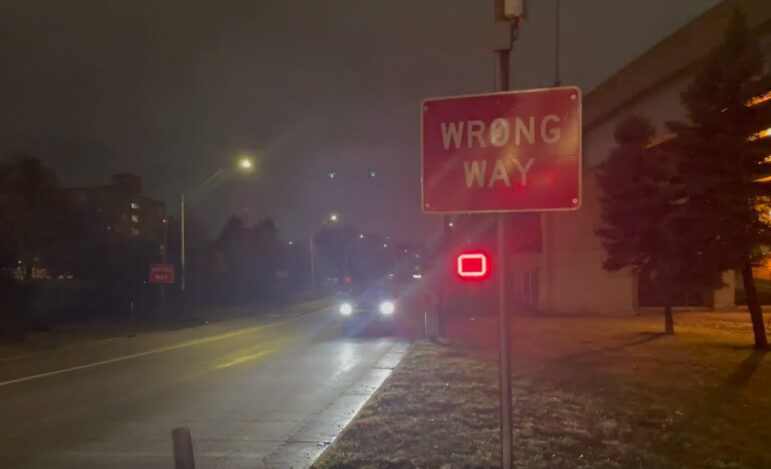
Michigan Department of Transportation
Signs light up as part of the state’s wrong-way driving detection systems.By KAYTE MARSHALL
Capital News Service
LANSING – The Michigan Department of Transportation, the State Police and the city of Grand Rapids are installing detectors to reduce the likelihood of wrong-way driving.
There were 2,008 deaths from wrong-way driving crashes on divided highways between 2015 and 2018 nationally, an average of 500 per year, according to the AAA Foundation for Traffic Safety.
Michigan has had at least 850 wrong-way crashes between January 2018 and May 2023, according to the State Police.
“They’re rare, but when they happen they’re typically catastrophic,” MDOT Director Bradley Wieferich said. Among them: In October, a wrong-way driver heading north on the southbound side of the Lodge Freeway in Detroit died in a head-on crash.
And in April, a wrong-way driver heading southbound in a northbound lane of US-131 in Grand Rapids killed a West Michigan pastor. The driver was charged with drunken driving and reckless driving causing death.
The state and city partners are approaching the problem by installing detection systems that will be added at interchange off-ramps along US-131 in Grand Rapids between Ann Street and M-11 (28th Street).
The systems are designed to warn wrong-way drivers by initiating a series of flashing lights on wrong-way signs. There also will be cameras in place to record such incidents, and authorities will be notified whenever a wrong-way driver is detected.
Similar systems are already installed at the northbound US-131 off ramp to Cherry Street, and the northbound US-131 off ramps (Hynes Avenue) to Hall Street in Grand Rapids.
Over the past several years, MDOT has added preventative safety measures to roadways.
They include reflective strips on “Do Not Enter” and “Wrong Way” signposts, stop line and turn arrows at ramp approaches, and turning guideline markings where on and off ramps are adjacent to each other.
The department also lowered “Do Not Enter” signs to improve headlight angles.
“There’s a lot of things that aren’t within our sphere of influence,” Wieferich said. “That’s why we need to work with enforcement, education campaigns and others to address this issue most holistically.”
In addition to the installation of preventative measures, MDOT has been researching what factors play a role in wrong-way driving accidents.
In 2012, safety researchers from MDOT and the Federal Highway Administration released a study of wrong-way driving that resulted in 110 crashes in Michigan from 2005 through 2009. Those crashes resulted from drivers presumed to have entered the freeway system by traveling the wrong way on an exit ramp.
“The first thing I noticed in the data is that the severity of these crashes, as a group, is off the charts,” MDOT traffic and safety engineer Mark Bott said in the study.
The study highlighted impaired driving as a major factor in wrong-way driving accidents, with almost 60% of wrong-way drivers having been under the influence of alcohol or drugs.
Nighttime conditions and visibility were also a significant factor in 78% of the studied crashes. That is part of the reason that the detectors have flashing lights on “Wrong Way” signs to warn drivers during both day and night.
“If you are a sober, alert driver and you don’t see a big red sign that says ‘Wrong Way’ then these flashing LED lights will definitely get your attention,” said MDOT media representative John Richard.
Richard acknowledged that the condition of the driver also has an impact on the likelihood of wrong-way driving crashes, and that not every variable in wrong-way incidents can be prevented by police and safety agencies.
“The No. 1 safety feature in any vehicle is always the driver,” Richard said. “Everything that we design and build is under the expectation that motorists are following the rules, paying attention, being courteous and staying sober at all times.”
“Human behavior is extremely difficult to engineer for,” he said.